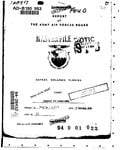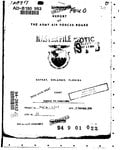Greg Boeser
1st Sergeant
Crew on the B-26 and the B-25 varied throughout the war based on the mission needs. As originally designed, both carried a crew of five, however the first B-26 units to deploy used crews of seven - pilot, co-pilot, navigator, enlisted bombardier, engineer, radioman and air gunner. B-25s carried a crew of six - pilot, co-pilot, navigator, bombardier, radioman, engineer/gunner. In the Pacific, a fully trained navigator was essential. The navigator's position was in a compartment directly behind the flight deck, so during flight it was common for the navigator to come forward and watch the action over the shoulders of the pilot and co-pilot. Once skip bombing was introduced, the bombardier was usually omitted from the crew to reduce manpower requirements, bombs being toggled by the co-pilot. However, even after most B-25s had been converted to strafer configuration, a few planes in each squadron retained the glazed nose for level bombing, each flight leader carrying a bombardier with bombsight, the others toggling on the lead ship's drop.One thing I wonder about is the role of Bombardiers and navigators and where they intersected. With the B-25 they had a bomb/nav, one man that did both jobs from his position in the nose. With the Martin B-26 in Europe they had both a bombardier and a navigator, with separate positions, although soon after takeoff it seems that the Nav went down to the nose and argued with the Bombardier over where they were, since both were trained both as navigators and bombardiers. Heavy bombers like the B-17 and B-24 seemed to have separate people in those positions, too.
By the way the Martin B-26 had the Norden bombsight, but in order for the bombardier to use the nose gun the bombsight had to be removed. I read of one mission where they were told to bomb an enemy troop concentration and then go down and strafe. The bombardier sighted through the Norden, dropped the bombs, and then as they turned around to strafe, removed the Norden and handed it to the Navigator, who held the bombsight while the Bombardier gleefully went to work with the .50 cal nose gun and the pilot strafed with the 4 package guns.
So how did they decide when they had a Bomb/Nav or separate positions?
Mediums in North Africa and Europe generally carried a crew of six, combining the roles of bombardier and navigator in a single crewman, the "bombagator", though the lead planes usually carried a veteran lead bombardier and lead navigator. Low level ops proved too dangerous, so formation attacks at medium altitude became the standard procedure. Since precision group bombing placed more emphasis on concentration than individual accuracy, the "bombagator" or "togglier" toggled off their bombs when the lead ship dropped. The reason heavies retained fully trained bombardiers and navigators, while the function was combined in the mediums probably had to do with the greater demands placed on long range, high altitude operations compared to the shorter range missions at lower altitudes of the mediums. Regarding crew reductions, there were suggestions that mediums could dispense with co-pilots, since, it was said, their only real role was raising and lowering the landing gear. A block of B-26s, the B-26C-6, was produced without a co-pilot's position, but these were quickly retrofitted in the field by unit commanders.
Interestingly, the B-26 and B-25 were supplanted by the Douglas A-26, which had no co-pilot, the navigator assisting the pilot when necessary. Produced in glazed and solid nose configurations, it continued the practice of wingmen toggling on the lead ship's drop.


